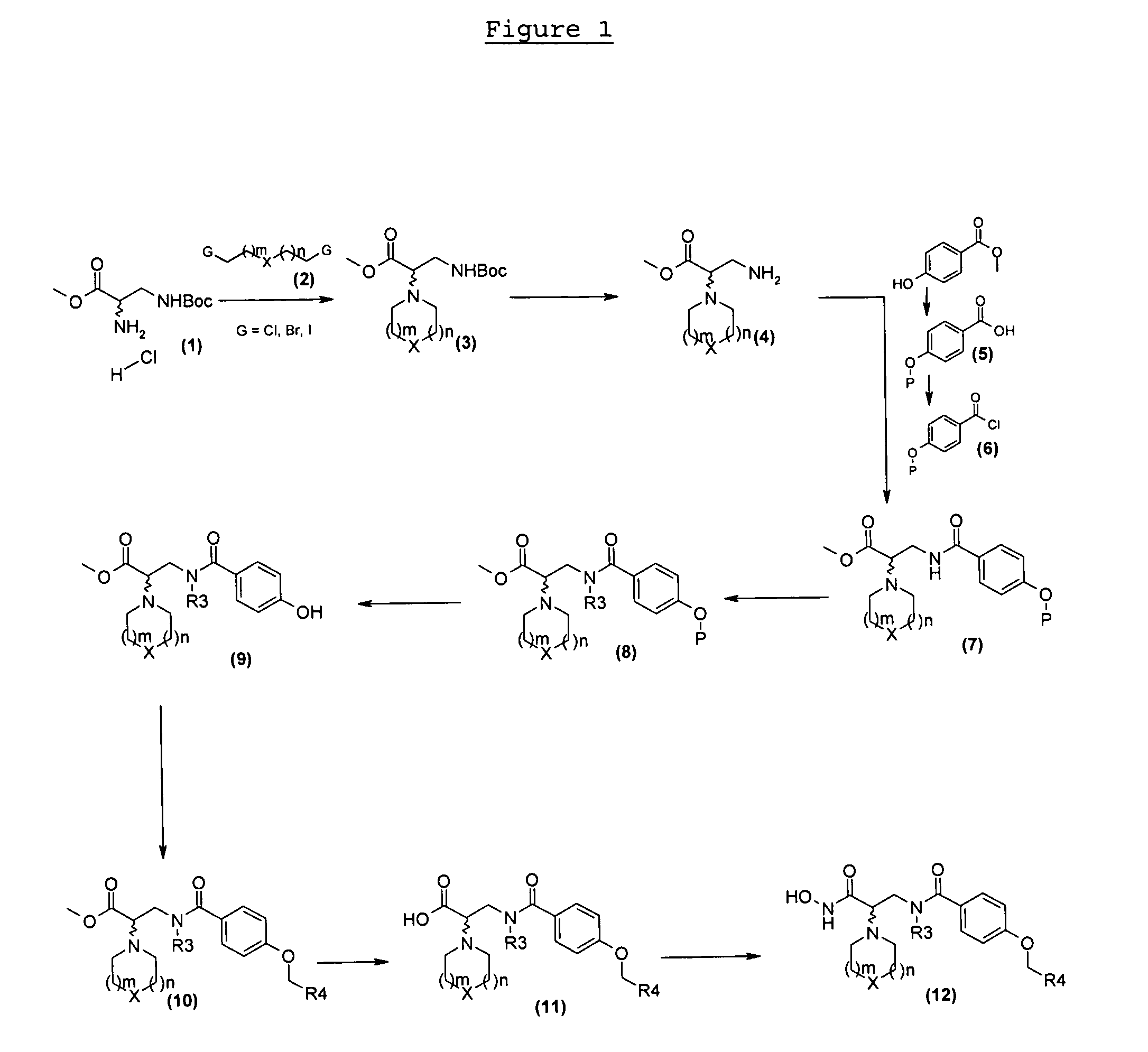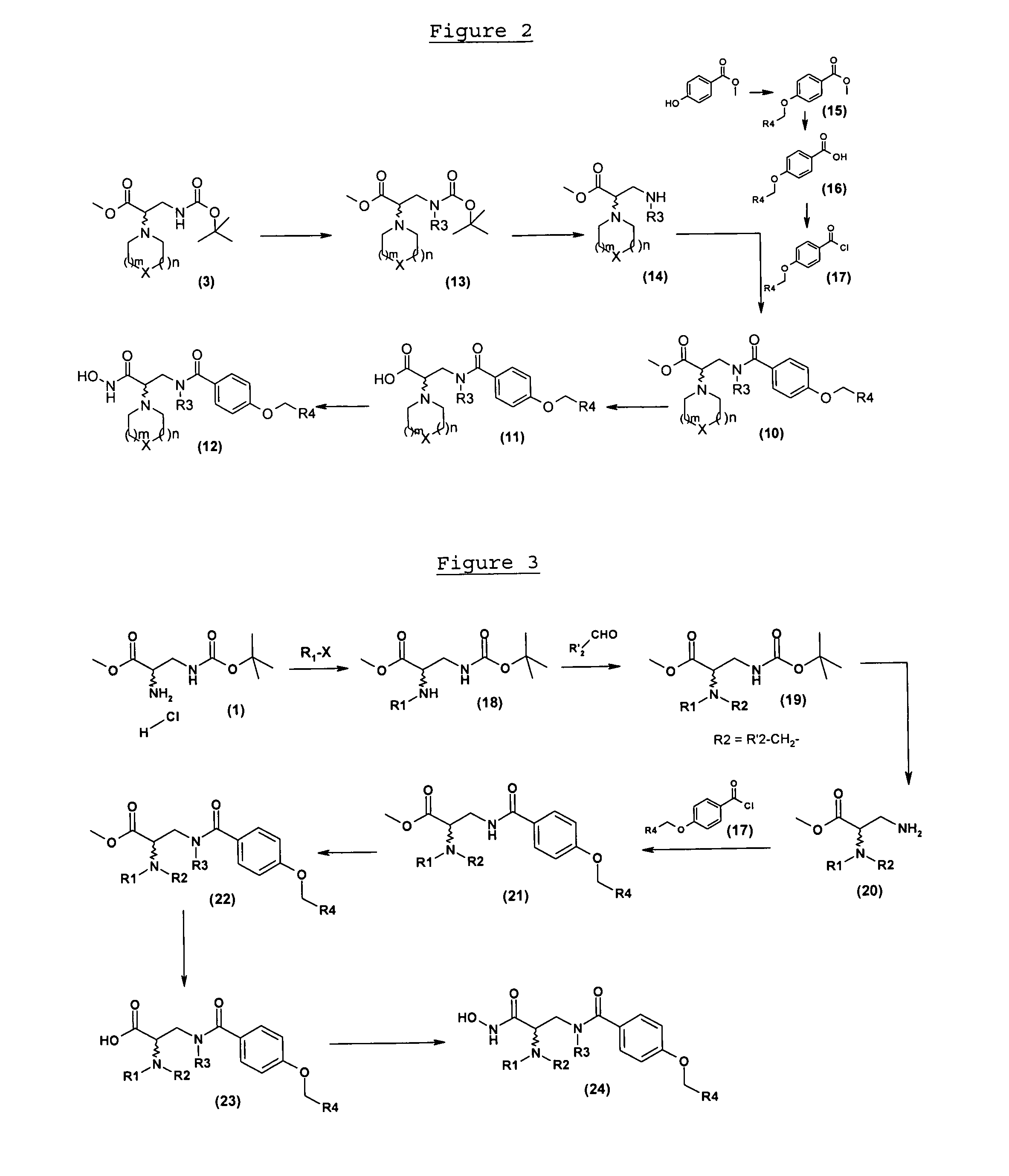4-alkoxy-n- (2-hydroxycarbamoyl-2-piperidinyl-ethyl) -benzamide compounds as selective tace-inhibitors for the treatment of inflammatory diseases
a technology of benzamide and alkoxycarbamoyl, which is applied in the field of benzenecarboxamide compounds, can solve the problem that inhibitors do not act selectively, and achieve the effect of inhibiting the secretion of soluble tnfcl
- Summary
- Abstract
- Description
- Claims
- Application Information
AI Technical Summary
Benefits of technology
Problems solved by technology
Method used
Image
Examples
example 1
4-but-2-ynyloxy-N-((S)-2-hydroxycarbamoyl-2-piperidin-1-ylethyl)benzamide
1-1: Methyl (S)-3-tert-butoxycarbonylamino-2-piperidin-1-ylpropanoate
[0140]1.8 ml (6.5 mmol) of triethylamine are added to a solution of 1 g (6.5 mmol) of commercial methyl (S)-2-amino-3-tert-butoxycarbonylaminopropanoate hydrochloride in 20 ml of tert-butanol. The reaction medium is stirred for 30 min at 40° C. then filtered. Added to the filtrate thus obtained are 1.2 ml (8.6 mmol) of 1,5-dibromopentane and the reaction medium is heated at 60° C. for 3 days. After filtration of the insoluble fraction, the filtrate is concentrated under vacuum. The crude residue is purified by chromatography over silica gel eluted with a 70 / 30 heptane / ethyl acetate mixture. 600 mg (49%) of methyl (S)-3-tert-butoxycarbonylamino-2-piperidin-1-yl-propanoate are obtained in the form of a colourless oil.
1-2: Methyl (S)-3-amino-2-piperidin-1-ylpropanoate dihydrochloride
[0141]A solution of 830 mg (2.8 mmol) of methyl (S)-3-tert-butox...
example 2
N-((S)-2-hydroxycarbamoyl-2-piperidin-1-yl-ethyl)-4-(2-methylquinolin-4-ylmethoxy)benzamide
2-1: Methyl 4-(2-methoxyethoxymethoxy)benzoate
[0148]3.2 g (78.9 mmol) of 60% sodium hydride are added to a solution of 10 g (65.7 mmol) of methyl 4 hydroxybenzoate in 50 ml of tetrahydrofuran and 50 ml of dimethylformamide. The reaction medium is stirred at ambient temperature for 20 minutes then 8.3 g (72.3 mmol) of 2-methoxyethoxymethyl chloride are added. After stirring for 24 h at ambient temperature, the mixture is poured over water then extracted with ethyl acetate. The organic phase is washed with water then with a saturated aqueous solution of sodium chloride, dried over magnesium sulphate, filtered and concentrated. 16 g (100%) of methyl 4-(2-methoxyethoxymethoxy)benzoate are obtained in the form of a colourless oil.
2-2: 4-(2-Methoxyethoxymethoxy)benzoic acid
[0149]15 g (375 mmol) of sodium hydroxide powder are added to a solution of 16 g (75 mmol) of methyl 4-(2-methoxyethoxymethoxy)b...
example 3
4-(2,6-dichloropyridin-4-ylmethoxy)-N-((S)-2-hydroxycarbamoyl-2-piperidin-1-ylethyl)benzamide
3-1: Methyl (S)-3-[4-(2,6-dichloropyridin-4-yl-methoxy)benzoylamino]-2-piperidin-1-ylpropanoate
[0155]500 mg (1.6 mmol) of methyl (S)-3-(4-hydroxybenzoyl-amino)-2-piperidin-1-ylpropanoate (prepared as described in Example 2.4), 320 mg (1.8 mmol) of 2,6-dichloropyridin-4-yl)methanol and 850 mg (3.3 mmol) of triphenylphosphine are put into solution in 15 ml of tetrahydrofuran then 0.5 ml (3.3 mmol) of diethyl azodicarboxylate are added. The reaction medium is stirred at ambient temperature for 18 h then 1 ml (6.6 mmol) of diethyl azodicarboxylate are again added. After stirring for 30 h, the mixture is concentrated and diethyl ether is added. After filtration and evaporation of the filtrate, the residue is purified by chromatography over silica gel eluted with a 70 / 30 heptane / ethyl acetate mixture. 200 mg (26%) of methyl (S)-3-[4-(2,6-dichloropyridin-4-ylmethoxy)benzoyl-amino-]-2-piperidin-1-yl...
PUM
 Login to View More
Login to View More Abstract
Description
Claims
Application Information
 Login to View More
Login to View More - R&D
- Intellectual Property
- Life Sciences
- Materials
- Tech Scout
- Unparalleled Data Quality
- Higher Quality Content
- 60% Fewer Hallucinations
Browse by: Latest US Patents, China's latest patents, Technical Efficacy Thesaurus, Application Domain, Technology Topic, Popular Technical Reports.
© 2025 PatSnap. All rights reserved.Legal|Privacy policy|Modern Slavery Act Transparency Statement|Sitemap|About US| Contact US: help@patsnap.com



